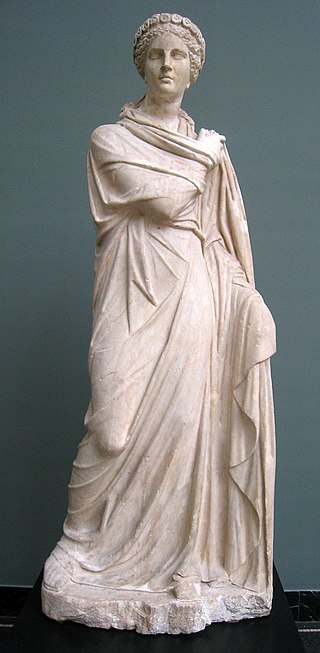Polyhymnia
Muse of sacred poetry in Greek mythology From Wikipedia, the free encyclopedia
Polyhymnia (/pɒliˈhɪmniə/; Greek: Πολυύμνια, lit. 'the one of many hymns'), alternatively Polymnia (Πολύμνια), is, in Greek mythology, the Muse of sacred poetry, sacred hymn, dance and eloquence, as well as agriculture and pantomime.

| Polyhymnia | |
|---|---|
Goddess of Hymns | |
| Member of the Muses | |
 Roman statue of Polyhymnia, 2nd century AD, depicting her in the act of dancing | |
| Abode | Mount Olympus |
| Genealogy | |
| Parents | Zeus and Mnemosyne |
| Siblings | Euterpe, Calliope, Urania, Clio, Erato, Thalia, Terpsichore, Melpomene and several paternal half-siblings |
| Children | Orpheus, Triptolemus |
Etymology
Polyhymnia name comes from the Greek words "poly", meaning "many", and "hymnos", which means "praise".[1]
Appearance
Polyhymnia is depicted as serious, pensive and meditative, and often holding a finger to her mouth, dressed in a long cloak and veil and resting her elbow on a pillar. Polyhymnia is also sometimes credited as being the Muse of geometry and meditation.[2]
In Bibliotheca historica, Diodorus Siculus wrote, "Polyhymnia, because by her great (polle) praises (humnesis) she brings distinction to writers whose works have won for them immortal fame...".[3]
Family
As one of the Muses, Polyhymnia is the daughter of Zeus and the Titaness Mnemosyne. She was also described as the mother of Triptolemus by Cheimarrhoos, son of Ares,[4] and of the musician Orpheus by Apollo.[5]
Dedications
On Mount Parnassus, there was a spring sacred to the Muses. It was said to flow between two big rocks above Delphi, then down into a large square basin. The water was used by the Pythia, who were priests and priestesses, for oracular purposes including divination.[2]
In popular culture
- In astronomy, there are ten asteroids named after the Muses, and moons named after another two. The one named after Polyhymnia is a main belt asteroid discovered by Jean Chacornac, a French astronomer, in 1854.[2]
- Polyhymnia appears in Dante's Divine Comedy: Paradiso. Canto XXIII, line 56, and is referenced in modern works of fiction.
Gallery
- Polyhymnia, Friedrich Ochs, 1857
- Polyhymnia, Milano
- Polyhymnia, Giovanni Baglione, 1620
- Polyhymnia, Francesco del Cossa, 1455 – 1460
- Polyhymnia, Giuseppe Fagnani, 1869
- Cast of Polyhymnia, Pushkin Museum, Moscow
See also
- Muses in popular culture
- Asteroid 33 Polyhymnia
Notes
References
External links
Wikiwand - on
Seamless Wikipedia browsing. On steroids.






